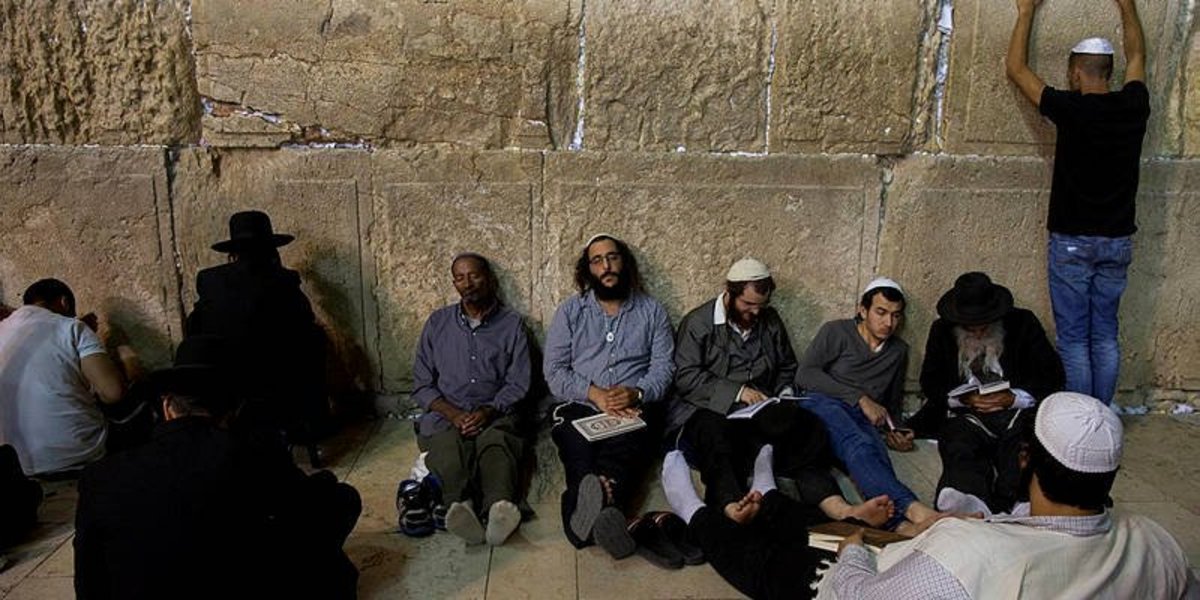
Based on a Shiur from Rabbi Eliyahu Brudny
Tisha B’av, as we all know, is a tremendous paradox. It is simultaneously a Yomtov, a fast-day, and a Yom Avel that all somehow go hand in hand. We sit on the floor like Availim and then, based on the Pasuk of "Koro Aloi Moed", we omit several sad parts of davening including lamnatzeiach, tachanun, or tzidkoscha tzedek. This is such a rare occurrence to have such a great discrepancy between the two parts of the day. It is confusing and needs explanation.
To understand Tisha B’av, we need to go back to an understanding of the root of Tisha B’av—: the episode of the Miraglim (spies). Following this episode, the Pasuk tells us Vayivku ha’am balaila hahu (the nation cried on that night) and following the destruction of the Bais Hamikdosh, the Pasuk in Eicha says Bacho Sivke Balaila (they cried at night). Chazal explain that the crying of the miraglim caused the crying of the churban habayis: Amar Hakadosh Boruch Hu, Atem bichisem bichiya shel chinam, va’ani ekva lochem bichiya l’doros, highlighting the connection between the cheit (sin) hamiraglim and the churban of Tisha B’av. To understand this connection, we first need to comprehend the essence of the cheit hamiraglim that triggered this bichiya shel chinam.
In Parshas Devorim, which is always read the week of Tisha B’av, Moshe refers to Klal Yisroel as narganim: vatairagnu b’oholeichem. At the end of Shaar Shlishi, Rabbeinu Yonah defines a nargan as someone who doesn’t appreciate a favor. Instead of trusting someone who is a maitiv, a nargan sees devious intentions. By telling us vatairagnu b’oholeichem, the Posuk is relating that this ideology was the essence of the cheit of Klal Yisroel on Leil Tisha B’av. They said B’sinas Hashem oisonu hotzeeanu mimitzrayim. Despite the miracles and the goodness reflected in Kriyas Yam Suf, the B’er, and the Ananei hakavod, they believed that Hashem hates us (the Sforno says this was ostensibly due to our being Oved Avoda Zara in Mitzrayim). Klal Yisroel lived with the notion that Hashem has an adversarial relationship with us. This was the essence of the Bichiya shel chinom. It was an attitude of failing to see the Ahava of Hakadosh Boruch Hu. And this is something that we continually struggle with.
The Pasuk in Eicha says Hisbiani Bamirorim Hirvani La’ana. The Midrash understands this as a connection between Pesach and Tisha B’av (incidentally, the first day of Pesach is always the same day as Tisha B’av) and says: Mima shehisbiana bilailai yom tov harishon shel pesach, hirvani b’leilei Tisha B’av la’ana. Hisbiani Bamirorim refers to the Maror we eat at Leil Seder. Hirvani La’ana refers to the poisonous weed which is symbolic of Tisha B’av, but is ineligible as maror. Pesach was hisbiani (satisfying), it may have tasted bitter—but it was nurturing and wholesome. However, this Maror somehow turns into the unpleasant la’ana of Tisha B’av. To understand the hisbiani function of Maror, we need to keep in mind the Gemorra’s instruction to follow the sequence that Maror can only be eaten following Matzo. Matzo represents cheirus, while maror represents avdus. It is easy to understand and feel Hashem’s love when times are good, as represented by the Matzoh. However, feeling this Ahava through times of tzara is more challenging. Eating maror during the leil seder is an expression of our appreciation that not only do we feel the love of Hashem during times of cheirus, but we feel it too during times of avdus. We understand that the vayimariru es chayeihem comes from the same loving place. We understand the concept of cheeshaiv es haketz. We understand that all the gzeiros and the koshei hashibud are all about viyadato im livovecha ki kaasher yiyaser ish es bno, hashem elokecha misayrecha. It all emanates from love. But we only understand this after experiencing the cherus of the Matzoh. This is why Maror needs to follow Matzoh and this is the satisfaction alluded to in the pasuk of hisbiani bamrorim. Unfortunately, we neglected to incorporate the true message of the maror. Instead of hisbiani bamrorim, it turned into hirvani La’ana. Beginning with the miraglim, we failed to understand this and didn’t recognize the ahava inherent in suffering. Every challenge and golus that followed is really all about this fundamental task—to find Hashem in the Maror, thereby reaching a matzav of hisbiani bamrorim.
Based on this concepts, we have the key to truly understand the moed of Tisha B’av and the reason for the confusion underlying it. This indeed is a unique combination: it is the greatest day of avel, but we hope to achieve an awareness that it all stems from ahava. The navi says habitu u’ru im yesh machov k’machovi. Yes, there is pain, but what is the source of this pain? Is it from an absent or adversarial ribono shel olam or does it come from kaasher yiyaser ish es b’no—from a loving father? Chazal wanted us to achieve this level of understanding. We sit on the floor as aveilim, but we will hopefully reach the point that it is truly not a yom tzara, that it really does come from ahava. We therefore are secretly joyous with this understanding and observe this moed by refraining from saying things like yaancha hashem b’yom tzara or tachanun.
The longer that we remain in galus, the more current this lesson is. We have gone through a year of tremendous tzaros, both on an individual as well as on a communal level. Every single person can relate to this. No one has an aggravation-free olam haze. Tisha B’av is a day to understand these principles. Every person in every situation is ki ka’asher yiyaser ish and we are bonim atem lahashem. Let us also remember that Moshiach was born on Tisha B’av. May we be zoche to nechomas yisroel bimhaira!
 Previous
Previous

